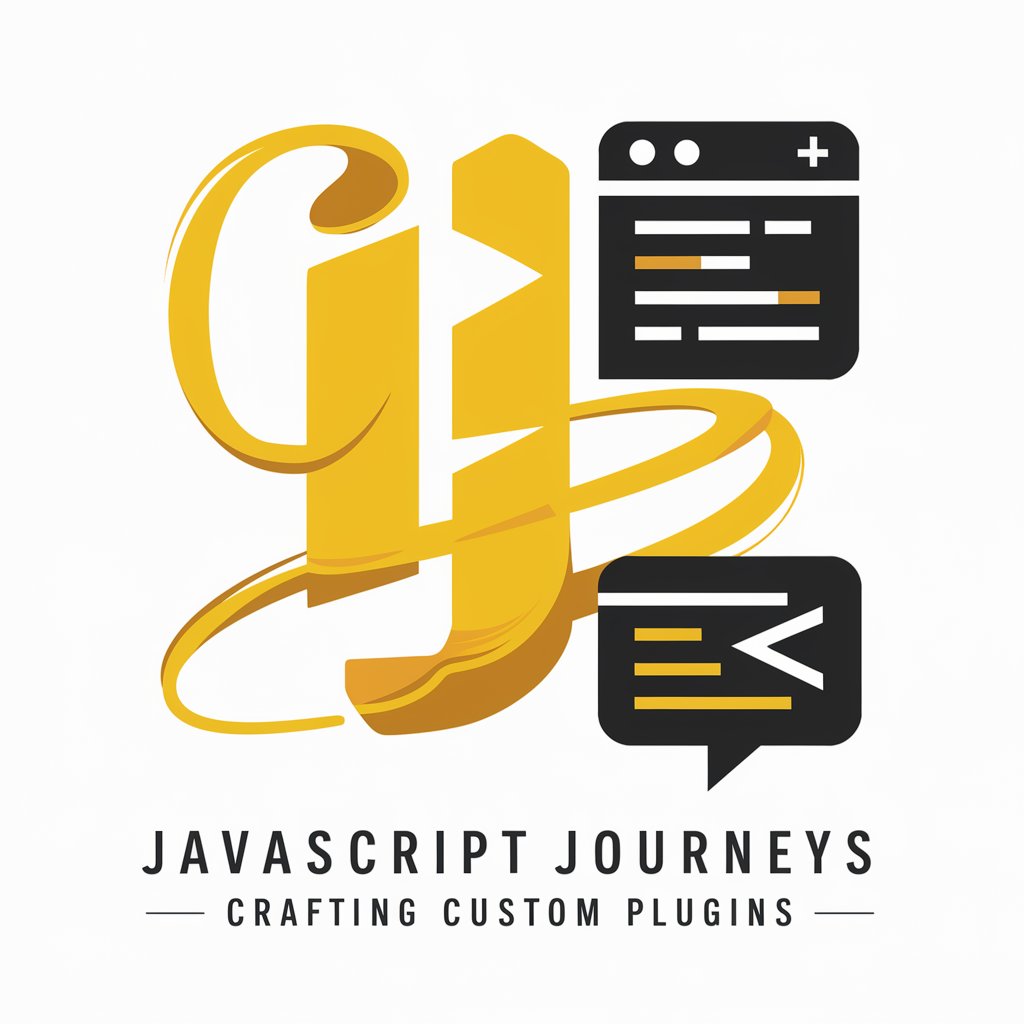
JavaScript Journeys: Crafting Custom Plugins - Custom JS Plugin Development

Welcome to JavaScript Journeys! Let's craft something amazing.
Craft dynamic web enhancements effortlessly.
Design a JavaScript plugin that...
How can I integrate my web application with...
What are the best practices for optimizing...
Can you provide an example of a custom...
Get Embed Code
Introduction to JavaScript Journeys: Crafting Custom Plugins
JavaScript Journeys: Crafting Custom Plugins is a specialized service focused on the development of bespoke JavaScript plugins for web applications. These plugins are designed to extend or enhance the functionality of websites by integrating new features, improving user interactions, or connecting with various web services. The primary design purpose revolves around creating scalable, maintainable, and performance-optimized plugins that are compatible across different browsers. Through custom development, it aims to provide solutions tailored to the specific needs of a project, ranging from adding interactive elements to a webpage, to processing data on the client side, or integrating third-party APIs for enriched functionalities. Examples include creating a plugin for real-time data visualization, developing a custom content slider that integrates with a CMS, or crafting a tool that enhances accessibility across a website. Powered by ChatGPT-4o。

Main Functions and Use Cases
Interactive User Interface Components
Example
Custom sliders, modals, and tabs
Scenario
In an e-commerce site, a custom slider plugin enhances the product viewing experience by allowing users to interactively browse through product images. A modal plugin can be used for promotional announcements, while custom tabs organize product details efficiently for easy access.
Data Processing and Visualization
Example
Charts, graphs, and data tables
Scenario
For analytics dashboards, a plugin can process raw data from server endpoints and render it as interactive charts or graphs, enabling users to visualize trends and metrics. Custom data tables could offer sorting, filtering, and pagination to manage large datasets effectively.
Third-party API Integration
Example
Social media feeds, payment gateways, or mapping services
Scenario
Integrating social media feeds into a website to show live updates, connecting to payment gateways for handling transactions in an online store, or embedding maps for location-based services. These plugins enhance functionality by leveraging external web services.
Accessibility Enhancements
Example
Keyboard navigation, screen reader support, contrast adjustments
Scenario
Developing plugins that automatically adjust web content for better accessibility, such as enabling keyboard navigation for users with mobility impairments, optimizing content for screen readers, or providing options to change contrast for those with visual impairments.
Target User Groups
Web Developers and Agencies
Professionals and companies specializing in web development who require unique functionalities that are not available through existing plugins or libraries. They benefit from custom solutions that precisely meet the project's requirements and enhance their web applications' value.
Businesses and E-commerce Platforms
Businesses looking to enhance their online presence with specialized functionalities such as advanced product displays, interactive user interfaces, or integration with business-specific tools and services. Custom plugins can provide a competitive edge by improving user experience and operational efficiency.
Educational and Training Institutions
Institutions that utilize e-learning platforms and require custom functionalities to deliver content interactively and effectively. Plugins can be developed to support unique educational tools, interactive learning modules, or integrations with academic databases and services.

Using JavaScript Journeys: Crafting Custom Plugins
Start with a Free Trial
Begin by visiting yeschat.ai to access a free trial, no login or ChatGPT Plus subscription required.
Identify Your Needs
Consider the specific functionality or enhancement you want to add to your web application. This could range from user interaction improvements to integrating external APIs.
Understand Plugin Architecture
Familiarize yourself with basic JavaScript and plugin development concepts to understand how to structure your plugin for easy integration and scalability.
Develop Your Plugin
Start coding your plugin. Use modern JavaScript ES6+ syntax for better performance and maintainability. Focus on making your plugin modular and easily configurable.
Test and Deploy
Thoroughly test your plugin across different browsers and devices to ensure compatibility and performance. Once satisfied, deploy your plugin to your web application.
Try other advanced and practical GPTs
🤖 AutoHotkey Form Filler
Streamline web forms with AI-powered automation.

🖥️ AutoIt Web Form Data Entry
Transform data entry with AI-driven automation

🎯 Cross-Compiling Mastery with CMake
Master cross-platform builds with AI

JavaScript Power for Real-Time Apps
Elevate interactivity with AI-powered real-time apps.

JavaScript to TypeScript Shift: Elevate Your Code
Elevate your code with AI-powered TypeScript conversion.

Senior Dev Mentor
Empowering Developers with AI Mentorship

HTMX and Tailwind UI/UX builder
Craft dynamic, responsive websites with AI-powered efficiency.

SafeGuardian AI
AI-Driven Emergency Preparedness

Gram
Empowering your journey with AI-driven guidance.

Mind Food and Body Guru
Empowering your wellness journey, powered by AI.

Sommelier AI: Your Digital Wine Expert
Unveil the world of wine with AI

Everything You Always Wanted to Know About Balkans
Explore Balkan history with AI power.

FAQs: JavaScript Journeys: Crafting Custom Plugins
What prerequisites are needed to start creating custom plugins?
A basic understanding of JavaScript, HTML, and CSS is essential. Familiarity with modern JavaScript features and asynchronous programming (Promises, async/await) will be very helpful.
Can these plugins be used with any JavaScript framework?
Yes, the plugins are designed to be framework-agnostic. However, you may need to make minor adjustments depending on the framework's architecture, such as React, Vue, or Angular.
How do I handle API integration in my plugin?
Use the Fetch API or XMLHttpRequest for making API calls. Ensure to handle both success and error responses gracefully and consider implementing caching for better performance.
What are some common use cases for custom plugins?
Common use cases include form validation, dynamic content loading, social media integration, data visualization, and custom user interaction effects.
How can I ensure my plugin is accessible and performs well?
Use semantic HTML, manage focus for keyboard users, and test with screen readers for accessibility. For performance, optimize your code for speed, minimize DOM manipulations, and use event delegation.






